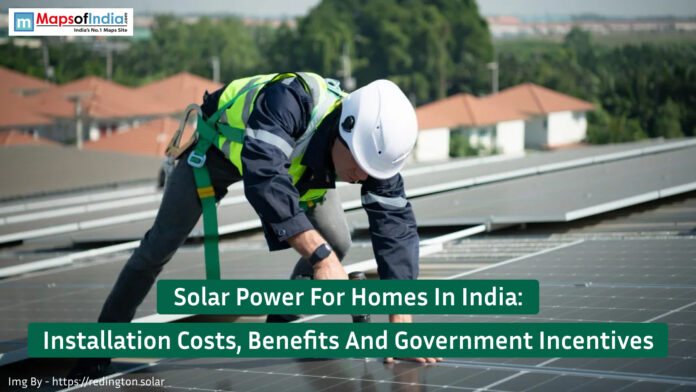Have you considered installing solar panels at your home? Solar power is a wise choice to help reduce your electricity bills and help the environment. Continue reading to learn how solar power works, the costs of installing solar panels, and the benefits you can gain from going solar in India. We also cover the subsidies offered by the Indian government to boost solar energy adoption.
Understanding Installation Costs
The price to install a solar power system varies depending on the size of the system and the type of components used. For a standard 1 kilowatt (kW) system in April 2024, homeowners can expect to pay between Rs. 75,000 to Rs. 1,25,000. The size of the inverter, the solar panel efficiency, and whether batteries are included for energy storage are some factors that affect the overall cost. Larger systems of 3-5 kW would involve higher installation expenses. They typically lie in the range of Rs. 3,00,000 to Rs. 5,00,000.
Benefits of Switching to Solar Power
Does it make financial sense to install solar? Once installed, a solar system can offer multiple advantages. Generating your electricity from the sun will significantly reduce your monthly electricity bills. Solar is also a cleaner energy alternative that does not pollute the air or contribute to climate change. Additionally, solar panels may increase your property’s value. Moreover, the government provides attractive incentives that make solar cost-effective over the long run.
Government Support for Solar Energy
Does the Indian government provide any incentives? Yes, the government wants more Indian homes to use solar power. Here are some key incentives you must be aware of before going solar:
- Under the PM-KUSUM scheme, up to 40% of Central Financial Assistance (CFA) is provided to install rooftop solar systems with a capacity of up to 3kW.
- Net metering is allowed across many states. Any excess power you send back to the grid gets purchased by utilities at the same rate as the domestic power tariff.
- Businesses can claim accelerated depreciation of 80% on solar assets in the first year post-installation.
- Many states offer additional incentives like SGST reimbursements and feed-in tariffs for solar power producers.
- Solar panels and parts attract lower GST rates of 5-18% versus standard rates of 18-28%.
Is Solar a Good Fit for Your Home?
Before investing in a solar installation, evaluate if your home meets certain criteria. An open rooftop facing south receives the maximum sunlight exposure needed to harness solar energy optimally throughout the day. You currently have high electricity bills, which could be significantly reduced by transitioning to solar power. Solar is a smart option if you opt for greener energy sources and want to play your part in reducing carbon emissions.
Taking the Next Steps
If solar energy seems suitable for powering your home, get customised proposals and quotes from three to five local installers. You must carefully review each system design and component included. Next, visit the Solar Rooftop website to find the applicable government incentives per your location. Most importantly, choose an experienced installer certified by the MNRE to design and install your solar system to current safety standards. With its many benefits, switching to solar energy is a prudent investment for a cleaner future.
Going solar is an excellent decision that benefits your home and the environment. Rapid technology improvements are increasingly making solar more affordable, so now is a good time to switch if it suits your household needs.




